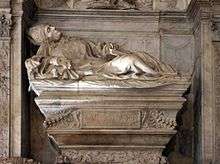Giovanni Michiel
Giovanni Michiel (* 1446 or 1447, died 1503) was an Italian Roman Catholic cardinal and bishop.

Biography
Giovanni Michiel was born in Venice sometime between April 1446 and April 1447, the son of Lorenzo Michiel and Nicolosa Barbo, sister of the future Pope Paul II.[1] A cousin, Giovanni Battista Zeno, was also a cardinal (1468).[1]
Early in his career, Michiel served as a protonotary apostolic. During this time, he lived with his uncle in the Apostolic Palace.[1]
His uncle made him a cardinal deacon in the consistory of November 21, 1468.[1] He received the red hat and the deaconry of Santa Lucia in Septisolio on November 22, 1468. He opted for the deaconry of Sant'Angelo in Pescheria ca. 1470.[1]
He was named Bishop of Verona in commendam on March 18, 1471; his entry into the see was delayed by the conflict between the Republic of Venice and the Holy See, but then occupied the office until his death.[1]
He participated in the papal conclave of 1471 that elected Pope Sixtus IV.[1] He left Rome with the pope on June 10, 1476 because of an outbreak of bubonic plague, traveling to Viterbo and Foligno; they returned to Rome on October 23.[1] He opted to become a cardinal priest ca. 1484, taking the titular church of San Marcello al Corso, though retaining Sant'Angelo in Pescheria in commendam.[1]
He participated in the papal conclave of 1484 that elected Pope Innocent VIII.[1] On September 15, 1484, he succeeded the incoming pope as Camerlengo of the Sacred College of Cardinals, and was elected to the post on January 9, 1485 until January 11, 1486.[1] The pope named him Bishop of Padua, but the Republic of Venice opposed this appointment and sequestered his revenues, with the result that Michiel resigned the see in March 1487.[1] On June 4, 1486, he was named legate a latare to the Patrimonium Sancti Petri and to the fortresses and castles of the Holy See.[1] He was named Inspector of the papal army raised against Ferdinand I of Naples and later led the negotiations that led to a peace treaty signed on August 11, 1487.[1]
On March 14, 1491, he opted to become a cardinal bishop, taking the suburbicarian see of Albano.[1] On October 10, 1491, he opted for the suburbicarian see of Palestrina.[1]
He participated in the papal conclave of 1492 that elected Pope Alexander VI.[1] On August 31, 1492, the pope named him suburbicarian bishop of Porto e Santa Rufina.[1]
When, as part of the Italian War of 1494–1498, French troops entered Rome on May 27, 1495, he and the pope left Rome for Orvieto.[1] He was named (titular) Latin Patriarch of Antioch on January 23, 1497.[1]
He died in Rome on April 10, 1503, two days after he was poisoned by his cook on the orders of Cesare Borgia.[1] He is buried in San Marcello al Corso.[1]
References
- Miranda, Salvador. "MICHIEL, Giovanni (between April 1446 and April 1447-1503)". The Cardinals of the Holy Roman Church. Florida International University.
| Catholic Church titles | ||
|---|---|---|
| Preceded by Giovanni Battista Cibo |
Camerlengo of the Sacred College of Cardinals 1484–85 |
Succeeded by Jorge da Costa |